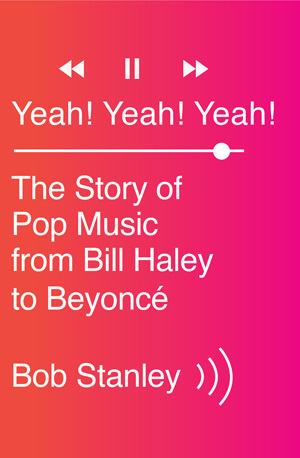‘Yeah! Yeah! Yeah!’ an eccentric, witty look at pop music history
By Korea HeraldPublished : Aug. 28, 2014 - 20:14
The title suggests the folly of the endeavor: “Yeah! Yeah! Yeah! The Story of Pop Music from Bill Haley to Beyonce.” Really? The whole story? Yeah, that’s what Bob Stanley is going for here. Doo-wop, the Beatles, folk rock, Philadelphia soul, punk and post-punk, Prince and Madonna, grunge, hip-hop, Britpop and so many points in between. All woven together in a semilinear narrative.
You can laugh if you want. Then you can try putting it down. Opinionated, digressive, quick to play favorites ― Stanley, a music journalist who also plays keyboards for the English indie dance band Saint Etienne, loves pop music the way a dog loves its master.
“I love the tensions between the industry and the underground,” he writes in his introduction, “between artifice and authenticity, between the adventurers and the curators, between rock and pop, between dumb and clever, between boys and girls.” He’s just the kind of fool to pull this errand off.
You can laugh if you want. Then you can try putting it down. Opinionated, digressive, quick to play favorites ― Stanley, a music journalist who also plays keyboards for the English indie dance band Saint Etienne, loves pop music the way a dog loves its master.
“I love the tensions between the industry and the underground,” he writes in his introduction, “between artifice and authenticity, between the adventurers and the curators, between rock and pop, between dumb and clever, between boys and girls.” He’s just the kind of fool to pull this errand off.

Stanley doesn’t cut a lot of corners; at 556 pages plus bibliography and index, “Yeah! Yeah! Yeah!” could be mistaken for a speaker cabinet. If he’s more insightful on acid house than he is on hip-hop (which he’s actually pretty strong on), he can be forgiven. The book’s pleasures lie in its eccentricities, its wit and its ability to make connections across decades and subgenres. This is, in fact, a narrative, or a rather a series of tributaries, in which the Brill Building succumbs to the Beatles, the sound systems of Jamaica sprout the roots of hip-hop, and Joy Division, rest in peace, becomes New Order.
He also has a knack for descriptions that zero in on the defining traits of artists and movements. “Bob Dylan was closed, entirely self-sufficient,” he writes. “He was his own planet and, naturally, you desperately wanted to find a way to travel there.” He’s not worried about tipping sacred cows, including John Lennon (“Double Fantasy, his last album released shortly before his death in 1980, was a thin stew of icky philosophies mushed in a blender until they resemble pureed carrot and peas”) and U2 (“They had become a complete inversion of everything post-punk had appeared to stand for: backward-looking, triumphalist, built for arenas.”)
At times he reads like his countryman David Thomson, whose “Biographical Dictionary of Film” series strives for maximum cattiness. But Stanley rarely condescends or strikes a pose of elitism. That, after all, would be so un-pop. He gives heavy metal its due: “Along with country, it’s quite likely it will outlast every other genre in this book.” And he does his best work in the nooks and crannies of pop history, and in the social currents of his native Britain.
You probably know enough about the Beatles, but what about their early contemporaries? Stanley introduces us to forgotten men of the early ‘60s like Billy Fury, who “looked and sounded exactly as a pop star should: He had fine bone structure, a tremulous voice and a real sense of mystery. On stage he wore gold lame suits, like Merseyside’s very own Elvis ― he could have passed for an American.” (Such descriptions make you lament the book’s lack of photos). On newer turf, Stanley captures England’s ‘80s panic over a new drug called ecstasy, which sent the British tabloids into a tizzy of hyperbolic headlines: “The New Sex and Drug Cult Exposed!”
“Yeah! Yeah! Yeah!” is by its very nature incomplete, its ambition impossible to meet. Where’s Nine Inch Nails? Where’s Jay-Z or Nas? To which I hear myself say, shut up and enjoy. Quixotic and kaleidoscopic, “Yeah! Yeah! Yeah!” serves up erudite irreverence on every page. Like its sprawling subject, it invites everyone in for a listen.
By Chris Vognar
(The Dallas Morning News)
(MCT Information Services)
-
Articles by Korea Herald


![[Exclusive] Korean military set to ban iPhones over 'security' concerns](http://res.heraldm.com/phpwas/restmb_idxmake.php?idx=644&simg=/content/image/2024/04/23/20240423050599_0.jpg&u=20240423183955)

![[Graphic News] 77% of young Koreans still financially dependent](http://res.heraldm.com/phpwas/restmb_idxmake.php?idx=644&simg=/content/image/2024/04/22/20240422050762_0.gif&u=)



![[Pressure points] Leggings in public: Fashion statement or social faux pas?](http://res.heraldm.com/phpwas/restmb_idxmake.php?idx=644&simg=/content/image/2024/04/23/20240423050669_0.jpg&u=)










